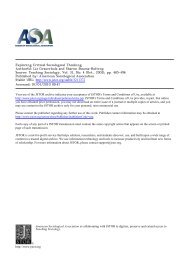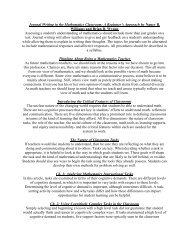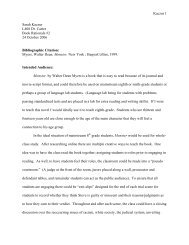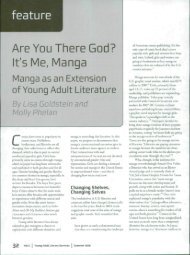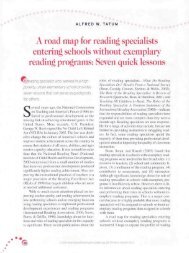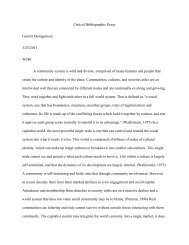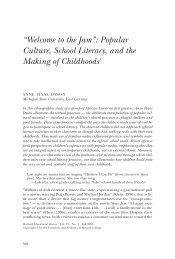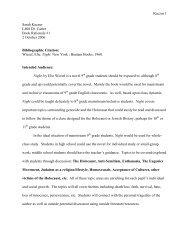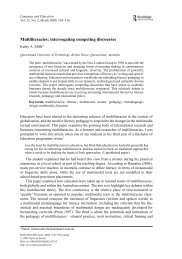McDonald 2004 Critical Reading 10-11 year olds.pdf - Oncourse
McDonald 2004 Critical Reading 10-11 year olds.pdf - Oncourse
McDonald 2004 Critical Reading 10-11 year olds.pdf - Oncourse
You also want an ePaper? Increase the reach of your titles
YUMPU automatically turns print PDFs into web optimized ePapers that Google loves.
Literacy April <strong>2004</strong> 17<br />
Moving from reader response to critical<br />
reading: developing <strong>10</strong>–<strong>11</strong>-<strong>year</strong>-<strong>olds</strong>’ ability<br />
as analytical readers of literary texts<br />
Lorraine <strong>McDonald</strong><br />
Abstract<br />
This article presents aspects of a research study into how<br />
a group of ten- and eleven-<strong>year</strong>-old students (in 5th<br />
Grade in Sydney, Australia) were apprenticed to view a<br />
literary text from critical reading positions. These ways of<br />
reading were an alternative to their more typical reader<br />
response interpretations of texts. The article contrasts<br />
‘non-critical’ and ‘critical’ classroom talk through a close<br />
examination of transcript excerpts, and compares these<br />
kinds of talk as discrete ways of thinking and speaking.<br />
The article argues for a response-analytical continuum<br />
which may support young readers in moving towards<br />
critical reading practices.<br />
Introduction<br />
Over the past few decades there have been radical<br />
shifts in the way that readers have been asked to<br />
respond to literary texts in schools. When I was reading<br />
novels as a school and university student I was taught<br />
to search for the author’s meaning, which was a kind of<br />
‘pre-determined’ entity I needed to seek out (Kempe,<br />
1993, p. 307). A decade later, when I was first reading<br />
children’s literature with primary-age students in<br />
Sydney, Australia, the relationship between the literary<br />
text and my students’ life experiences was the focus for<br />
reading and for teaching (Luke and Freebody, 1997, p.<br />
189). I suggest that this ‘reader response’ view of<br />
reading stories remains a dominant way of working<br />
with stories in classrooms today. More recently, reading<br />
pedagogy has drawn on a poststructuralist theory<br />
of texts in order to construct analytical, or critical,<br />
reading practices. To highlight the distinctions between<br />
reader response practices and critical reading<br />
practices, a brief summary of these different discursive<br />
positions is outlined.<br />
Reader response practices<br />
Reader response views of reading assert that readers<br />
utilise their lived social, political and economic reality,<br />
their knowledge of their own culture and their knowledge<br />
of other cultures to make meaning from texts.<br />
These experiences are all regarded as part of the<br />
‘repertoire’ readers bring to an interpretation of<br />
literature (Iser, 1978). Thus, the subjectivity of the<br />
interpretative act is acknowledged and encouraged. In<br />
general, reader response practices promote the alignment<br />
of readers with the literary text through readers’<br />
emotional participation with characters and analogising<br />
of experiences.<br />
In the reader response classroom, readers are expected<br />
to be active participants in constructing meaning from<br />
the text. Students’ interpretations of stories are<br />
encouraged and these interpretations are perceived<br />
to be ‘individual’, the product of an autonomous and<br />
conscious ‘self’. While readers are free to disagree with<br />
the meanings in the text, they do so from a subjective<br />
position. Baker (1992, 1997) argues that these responses<br />
and interpretations are constituted in the students’<br />
cultural knowledge. In summary, reader response<br />
discourse has informed classroom practice in English-speaking<br />
countries for the past two decades.<br />
Critique of reader response<br />
<strong>Critical</strong> reading practices have developed within a<br />
poststructuralist view of reading, and offer a critique of<br />
‘reader response’. From a poststructuralist view, when<br />
the personal experiences of the reader are integrated<br />
with the experiences of the characters, the subjectivity<br />
of the reader melds with the text. Arguably, when the<br />
reader’s stance is at one with the reader position<br />
constructed by the literary text, the ‘ways of thinking<br />
or being’ promoted by the text, that is, the text’s<br />
‘discourses’ (Gee, 1996), remain hidden, and a truly<br />
‘critical’ perspective is difficult to attain. Furthermore,<br />
despite emphases in reader response on the freedom of<br />
the reader, Winser (1993, p. <strong>11</strong>4) notes that students<br />
‘‘are vulnerable’’ because of implicit ‘‘pressure to come<br />
up with a canonical reading, one that is socially<br />
approved in the school context’’. This is a hidden<br />
expectation of the practice of reader response, as<br />
Freebody (1991) noted in his study of examiners’<br />
remarks on Australian high-school students’ responses<br />
to literature examination questions.<br />
<strong>Critical</strong> reading practices<br />
<strong>Critical</strong> reading models assert that texts position<br />
readers in certain ways. In this approach to reading,<br />
r UKLA 2003. Published by Blackwell Publishing, 9600 Garsington Road, Oxford OX4 2DQ, UK and 350 Main Street, Malden, MA 02148, USA.
18 Moving from reader response to critical reading<br />
students investigate how this positioning occurs, and<br />
they may offer resistant readings to ‘mainstream’ ways<br />
of thinking articulated in the story. In this article, the<br />
term ‘mainstream’ signifies an assumption of ‘normal’,<br />
‘typical’ and ‘universal’ for dominant social and<br />
cultural practices (Baynham, 1995, p. 43). <strong>Critical</strong>/<br />
analytical practices have been seen, therefore, to<br />
propose an alternative to dominant reader-response<br />
interpretations of texts. The research presented here<br />
suggests, however, that a reader response stance can<br />
contribute to the formation of a critical reading<br />
position. The article concludes with the notion of a<br />
response-critical continuum which may be a useful<br />
concept for introducing young readers to alternative<br />
ways of thinking about literary texts.<br />
The term ‘critical reading’ here encapsulates alternative<br />
ways of reading which go beyond typical<br />
approaches to reading as word recognition, information<br />
processing, and personal response. Today, critical<br />
ways of reading are intended to construct readers who,<br />
for example, can identify texts as crafted objects, who<br />
are alert to the values and interests espoused by the<br />
text, who recognise their position as compliant or<br />
resistant readers. When readers perceive texts as<br />
motivated, rather than innocent, they position themselves<br />
within an alternative discourse of reading,<br />
participating in a critical literacy. Current Australian<br />
English syllabi require teachers to employ pedagogies<br />
that enable students to take up a position within such<br />
an alternative reading discourse.<br />
Educational issues in literature for primaryage<br />
students<br />
When children’s literature is presented in a classroom<br />
it gains authenticity and authority from its educational<br />
setting. Stories have the ability to ‘naturalise’ their<br />
ideological positions and they ‘subject’ readers to<br />
become their ‘ideal’ readers, that is, to produce<br />
readings that align with the views of the text. As<br />
Candlin states, ‘‘children’s fictional texts are engaged<br />
in a struggle for young people’s minds’’ (Candlin,<br />
1992, p. ix; see also Stephens, 1992).<br />
Furthermore, current reading approaches do not<br />
position teachers to challenge the ways of thinking<br />
and being (the discourses) that stories portray in<br />
classroom texts. The discourses stories present are<br />
perceived as unproblematically ‘neutral’ by these<br />
reading approaches, and by teachers. As discursive<br />
practices, however, all stories constitute, and are<br />
constituted by, ways of thinking which typically<br />
present mainstream views on gender, ethnicity and<br />
social groups. Recently, literary texts which challenge<br />
these mainstream views have been published, and rereadings<br />
of older texts problematise previous interpretations<br />
(for example, The True Story of the Three Little<br />
Pigs, Scieszka, J. (1989), Snow White in New York, French,<br />
F. (1986); see also Bradford, 1996).<br />
The role of the teacher in reading practices<br />
In any classroom, the teacher is the interpretative<br />
authority on the text for the students. The narrative is<br />
filtered through the teacher’s talk about the text, that is,<br />
the teacher mediates the text to the students. As Luke<br />
and Luke (1989, p. 252) note, ‘‘[t]acitly and intentionally,<br />
teachers will emphasize and de-emphasize, select<br />
and exclude’’. The text becomes remade through this<br />
‘‘running metatextual commentary’’ (Luke, de Castell<br />
and Luke, 1983, p. <strong>11</strong>8). Baker’s research on talk in<br />
reading lessons (1991a, 1991b, 1992; and Baker and<br />
Freebody, 1989a, 1989b) highlights how, in the metatextual<br />
commentary, students are ‘‘asked to look<br />
through the text into the story, and through talk into<br />
the world. The text and the talk remain transparent and<br />
unread’’ (Baker, 1991b, p. 176). Together, Baker argues,<br />
the text, and the teacher’s talk about the text,<br />
‘naturally’ construct a subject position within dominant<br />
ways of thinking for the student.<br />
The study<br />
The research discussed in this article was a case study<br />
of how one teacher sought to introduce her students to<br />
critical ways of reading that were distinct from the<br />
interpretative responsive readings employed by the<br />
class and herself in other lessons in the study. The<br />
reading programme took place with students aged ten<br />
to eleven <strong>year</strong>s, in a Year 5 classroom in Sydney,<br />
Australia. The text was a children’s novel which the<br />
teacher read aloud to the class on a daily basis over a<br />
period of a school term (ten weeks). Information about<br />
the study-class cohort is summarised in Table 1.<br />
As can be seen from Table 1, the class contained a<br />
balance of ESB and NESB students, and gender, and<br />
had a wide range of reading abilities. It was important<br />
for the effectiveness of the study that the students not<br />
be categorised as high ability. The teacher and I wanted<br />
to ensure that any critical ways of reading achieved in<br />
the classroom dialogue could be attributed more to the<br />
kinds of talk about literature promoted in the classroom<br />
interaction, rather than to general high reading<br />
ability or a well-established English-speaking background.<br />
The text selected for the study was I am Susannah<br />
(1987), an Australian novel by a multi-award winning<br />
Australian author, Libby Gleeson. The major characterisation<br />
in the novel presents three generations of<br />
women, the protagonist, 12-<strong>year</strong>-old Susie, her mother<br />
Martha, and an elderly neighbour, Jess, known as the<br />
Blue Lady. Each of these characters is ‘matched’ by<br />
another female character who represents more traditional<br />
ways of being for women.<br />
The students responded to the novel through discussion<br />
of various features, events and characters at a<br />
r UKLA 2003
Literacy April <strong>2004</strong> 19<br />
Table 1: Summary of information about study class cohort<br />
Number of students 30<br />
Chronological ages<br />
<strong>10</strong>.4 to <strong>11</strong>.6 <strong>year</strong>s<br />
<strong>Reading</strong> ages n<br />
7.3 to <strong>11</strong>.9 <strong>year</strong>s<br />
Gender balance<br />
17 girls, 13 boys<br />
Language background 46% English Speaking Background (ESB)<br />
54% Non-English Speaking Background (NESB)<br />
[Lebanese 5 Italian 1<br />
Chinese 3 Egyptian 1<br />
Armenian 2 Korean 1<br />
Sri Lankan 2 Portuguese 1]<br />
Total no. of students classified as<br />
learners of English as an<br />
additional language<br />
<strong>11</strong><br />
(Source: Class teacher)<br />
n<br />
<strong>Reading</strong> ages as per the Progressive Achievement Test (A) in <strong>Reading</strong> Comprehension (ACER, 1986)<br />
whole-class level. These lessons took place at different<br />
times before lunch (1pm) and ranged from between 40<br />
and 70 minutes in length. The reading of the novel was<br />
considered a part of the ‘shared reading’ aspect of the<br />
literacy programme and the teacher placed importance<br />
on developing a community of readers (Fish, 1979)<br />
who talk about a good book together (personal<br />
communication). Some students obtained a copy of<br />
the novel and followed the teacher’s reading.<br />
A non-critical pedagogy: students’ stories<br />
In the study the teacher wanted to develop classroom<br />
talk which could be seen to construct moves towards<br />
critical reading. To achieve this, she not only paid<br />
attention to grammatical, narrative and gender perspectives<br />
in the novel (‘critical talk’) but also encouraged<br />
students’ personal stories as responses to the<br />
novel, which I have called ‘noncritical’ talk. In each of<br />
these lessons this ‘story-telling’ positioned the students<br />
to empathise with the novel’s events and the<br />
characters’ actions and reactions in relation to those<br />
events. Table 2 below presents examples of the<br />
relationship between text stimuli and the students’<br />
stories. Lessons 1 and 7 will be discussed as exemplars<br />
of a non-critical pedagogy.<br />
As Table 2 shows, the students were encouraged to<br />
align their experiences with those attributed to the<br />
characters in the novel. This deliberate foregrounding<br />
of the students’ repertoire was particularly important<br />
in Lesson 1, when the teacher (T) drew on the students’<br />
experiences of friendship to introduce the novel, as can<br />
be seen in the excerpt below. In each excerpt that<br />
follows the numbers indicate the turns taken and their<br />
place in the lesson sequence. For example, 1 T indicates<br />
that this excerpt is part of the teacher’s opening<br />
monologue:<br />
1T<br />
Now what I want you to do is think about the<br />
friends you have had since you’ve first started being<br />
conscious of the importance of a friend in your life.<br />
Let’s do a little bit of thinking. Who are the friends<br />
who have been special to you . . . Now hands up<br />
those of you who have had or have a special friend<br />
that has been part of your life for a lot of that time,<br />
lot of those <strong>year</strong>s. Yeh, many of you, ok. Could we<br />
just talk about those friends for a moment. The<br />
long-term friends, people who’ve been part of your<br />
Table 2: Examples of the relationship between the study lessons, text stimuli and students’ stories<br />
Lesson Text stimulus Story topics<br />
Lesson 1 Susie’s best friend announces she is leaving Leaving friends, or being ‘left’ when<br />
friends leave: friendship stories<br />
Lesson 7 Susie uses her mother as an ‘excuse’ to her peer Times when students have made<br />
‘excuses’ to avoid doing something<br />
Lesson <strong>10</strong> Susie’s mother takes her shopping for party clothes Improvisations of scenes based on<br />
experiences of going shopping for<br />
clothes with mum<br />
Lesson 15 The activities of the Blue Lady as artist Grandparent stories, their activities and<br />
relationships with the students<br />
r UKLA 2003
20 Moving from reader response to critical reading<br />
life for quite some time, let’s just talk about them. I<br />
don’t want you to name names, but what are the<br />
qualities in those friends that you enjoy? What’s<br />
kept you friends over this period of time? Yes?<br />
(Lesson 1)<br />
96S<br />
<strong>10</strong>2S<br />
Her mind is really confused because if she does<br />
go, she might forget about Kim. If she doesn’t go<br />
she’ll lose more friends.<br />
If she’d stop lying, she wouldn’t be in all this<br />
trouble. (Lesson 7)<br />
In this monologue the teacher deliberately invited<br />
discussion from the students’ lived experiences. She<br />
asked them to think about ‘friendship’ in a particular<br />
way: friends were ‘important’, ‘special’, ‘long-term’<br />
and have ‘qualities . . . you enjoy’. For these students<br />
the concept of friendship was constructed as enduring,<br />
rather than ephemeral, and this was perfectly aligned<br />
with the opening paragraph of the novel to be read<br />
aloud further into the lesson.<br />
Students’ stories were elicited when the teacher asked<br />
about friends who ‘‘had to leave for some reason. Or<br />
you had to leave . . . ’’ (50 T, Lesson 1). For example:<br />
67S<br />
73S<br />
Before when I lived in Turkey, my best friend,<br />
she, her dad got transferred to Canada and my<br />
dad got transferred to Turkey and then my dad<br />
got transferred to here and we haven’t stopped<br />
writing and we still keep in touch<br />
When my friend moved, I haven’t seen her for a<br />
couple of <strong>year</strong>s and when I did we had nothing to<br />
talk about<br />
80T . . . Now everyone, the class novel we are<br />
starting today, is in fact a story of a great<br />
friendship and a friendship which actually starts<br />
at the beginning of the story with an announcement<br />
by one of the main characters that she is<br />
leaving, that she is going (Lesson 1)<br />
The public space of the classroom reconstrued the<br />
experiences of individual students, when shared, as<br />
community experiences. Here the teacher constructed<br />
a group experience which aligned with the experiences<br />
of the protagonist: she positioned her students to read<br />
from ‘within’ the text. What counted as reading here<br />
was perceiving characters as ‘humans’ whose ‘life’<br />
experiences reflected those of the readers. The students’<br />
stories contributed to the development of a<br />
reader response discourse.<br />
In Lesson 7, the teacher promoted the students’<br />
empathy for the protagonist Susie by asking for<br />
inferences about Susie’s ‘excuse’ that her mother may<br />
not let her attend the planned party, as can be seen in<br />
the following excerpt:<br />
85T<br />
88S<br />
90S<br />
92S<br />
94S<br />
. . . What is really at stake for Susie in all of this<br />
party stuff? What is really there for her?<br />
She could lose her self-confidence after if the boy<br />
said something like you are disgusting.<br />
Like if she has a good time and forgets about<br />
Kim.<br />
She could be humiliated at the party.<br />
If she goes and she doesn’t play the game, she<br />
will lose her friends.<br />
In this excerpt the students inferred a variety of<br />
reasons for Susie’s excuses to her friends. These<br />
reasons were constructed from the students’ cultural<br />
logic and made Susie’s words plausible. Evidence for<br />
this claim lies in the language of the students:<br />
inferences are apparent in the students’ consistent<br />
use of the conditional conjunction ‘if’ (88S, 90S, 94S,<br />
96S, <strong>10</strong>2S) and the modal language of probability<br />
‘could’ (88S, 92S) and ‘might’ (96S). Furthermore, the<br />
kind of information they gave concerned the character’s<br />
feelings and behaviours, and this is evident in<br />
the students’ use of such ‘mental’ and ‘behavioural’<br />
types of verb as ‘forget/s’ (90S, 96S), ‘humiliated’ (92S),<br />
‘confused’ (96S), ‘lying’ (<strong>10</strong>2S), and such metaphorical<br />
constructions as ‘lose her self-confidence’ (88S) and<br />
‘lose her friends/lose more friends’ (94S/96S). What<br />
counts as reading here is the ability to project possible<br />
feelings and behaviours onto a character and to make<br />
deductions from the character’s thoughts. In this part<br />
of Lesson 7, this kind of classroom talk could be seen as<br />
an instance of ‘reader response’ theory applied in<br />
classroom practice.<br />
The teacher’s commentary on each response (not<br />
included in the example above) indicated her agreement<br />
with both the content of the students’ replies and<br />
the strategy they used to arrive at their answers. Such<br />
comments as ‘‘I have not thought of that’’ (91 T), and<br />
her sharing ‘‘I have had a few [embarrassing experiences]<br />
that are unbelievable’’ (97 T) gave authority to<br />
the use of this strategy of projection into a fictional text.<br />
The students’ projection of real-world cultural/social<br />
knowledge of how friendships ‘work’ was continued<br />
in line <strong>10</strong>2S: ‘If she’d stop lying, she wouldn’t be in all<br />
this trouble’’, where a student challenged the empathetic<br />
stance of the group’s responses.<br />
When this student resisted the reading position<br />
constructed by the teacher, she took up a critical<br />
stance. The student’s comment offered the possibility<br />
of an analytical reading: the teacher could have<br />
examined the potentiality of different reader positions,<br />
for example, are readers meant to agree with Susie’s<br />
‘excuses’ and reticence, or disagree? Arguably, the<br />
teacher deliberately remained within the reader<br />
response discourse, ignoring the challenge and using<br />
the comment as a springboard for more personal<br />
stories, as can be seen in the excerpt following:<br />
<strong>10</strong>2S<br />
<strong>10</strong>3T<br />
If she’d stop lying, she wouldn’t be in all this<br />
trouble.<br />
Yeh, let’s, yeh good. Let’s talk about that. You are<br />
right spot on that is where I want to be. Have<br />
you ever made up an excuse before, to cover<br />
r UKLA 2003
Literacy April <strong>2004</strong> 21<br />
<strong>10</strong>4S<br />
128S<br />
130S<br />
yourself for something you either didn’t want to<br />
do or felt uncomfortable about or . . . you felt<br />
that you couldn’t tell the truth. You had to make<br />
up an excuse. . . . Anybody want to talk about<br />
when they did something like that?<br />
Well, one day I was at Corey’s house and I was<br />
sick and her dad got really angry and he was<br />
calling me sook for being sick and so a few weeks<br />
later, Corey asked me to stay the night and I said<br />
Oh sorry we’re going out.<br />
When Jim was here . . . I slept over at his place<br />
twice and the first time Kieran his friend lived<br />
like two roads across, he kept asking if he could<br />
come over in front of everyone, and we said that<br />
we were going out, and once he came over and we<br />
were there. And we had to say we were just<br />
leaving.<br />
One time I went out to my auntie’s and she said<br />
something bad about my mother and then I went<br />
home. A couple of weeks later she asked me to go<br />
up there again and I said no I’m going away.<br />
(Lesson 7)<br />
In this excerpt the teacher did not take up the<br />
possibility of an analytical reading. Instead the<br />
relationship of the character’s life to human experiences<br />
was foregrounded as the students were encouraged<br />
to position themselves in similar ways to Susie,<br />
this time through their personal stories. Here the<br />
role of the students’ stories moved beyond establishing<br />
repertoire for the events of the novel: the stories<br />
themselves became integral to the making of<br />
inferences, the reasoning about the character’s motivations.<br />
A critical pedagogy: orienting students<br />
towards analytical talk<br />
One way ‘critical’ talk was introduced was through<br />
particular attention to specific gender perspectives<br />
presented in the novel. The characterisation of the<br />
novel’s three female generations permitted class<br />
discussion about alternative possibilities available to<br />
women of different ages. In these lessons the characters<br />
were ‘appraised’ in the light of how they lived their<br />
lives in the novel. Segments from two lessons, Lessons<br />
<strong>11</strong> and 15, will be discussed to demonstrate this focus.<br />
Appraising characterisation from a<br />
‘difference’ perspective<br />
The teacher encouraged appraisal by framing the<br />
classroom talk with a question which asked the<br />
students to consider ‘‘what makes the women in this<br />
story different . . . from typical female characters . . .<br />
that you have encountered’’ (Lesson <strong>11</strong>). The teacher’s<br />
question offered a subject position of critic: the<br />
students may situate themselves as analysts of<br />
characterisation, from a perspective which recognises<br />
that characters are ‘constructed’ by authors, rather<br />
than as responders to characterisation, from a perspective<br />
which perceives characters’ activities and<br />
qualities as representations of life.<br />
The students’ responses indicated their attempts to<br />
take up the position of analysts who can make<br />
generalisations about ‘typical’ female characterisation.<br />
They did this in several ways, as can be seen in the brief<br />
examples following, taken from different points in the<br />
talk:<br />
85S<br />
126S<br />
143S<br />
147S<br />
Sometimes – like she [Susie] hates people, other<br />
characters like people<br />
Usually the main character in the book – they are<br />
not as quiet – more open<br />
It is a writing technique<br />
She gets away – some other books are not very<br />
detailed. The girls normally just take one second<br />
in the shop but in this book it’s like a big thing,<br />
going to the shops (Lesson <strong>11</strong>)<br />
The teacher’s question had reframed the alreadyestablished<br />
qualities of some of the novel’s characters<br />
as atypical qualities of fictional female characters.<br />
Some student responses constructed a ‘typical’ characterisation<br />
as simply the opposite of the character’s<br />
known qualities (for example, 85S, while others drew<br />
on the verisimilitude of realistic fiction as in 126S). Two<br />
other students, however, perceived a deliberate construction<br />
of the ‘difference’ perspective: one student<br />
named it ‘a writing technique’ (143S) and a second<br />
student elaborated on this with a recognition of how<br />
the novel privileges female preoccupations. In the<br />
comment ‘‘in this book, it’s like a big thing, going to the<br />
shops’’ (147S) the student noted the narrative space<br />
and detail given to ‘going shopping’ and observed how<br />
‘other’ books do not chronicle this kind of event. These<br />
two students’ comments appear to recognise how<br />
‘different’ characterisation of females must be deliberately<br />
constructed as an alternative to ‘typical’ female<br />
mainstream characterisation, that is, ‘different’ (gendered)<br />
characters are constructed through the ‘different’<br />
(gendered) events in which they participate.<br />
Contrasting gendered characterisation<br />
To differentiate between the ‘ways of being’ represented<br />
by the two elderly women in the novel, the<br />
mysterious ‘Blue Lady’ and Mrs Watson, the teacher<br />
used contrasting language ‘balance-counterbalanceopposite-contrast’<br />
(1 T). A number of perspectives on<br />
elderly women were identified by the students in the<br />
classroom talk, as the excerpts below indicate.<br />
1T<br />
Which woman in the story is an interesting<br />
balance, counterbalance maybe would even be a<br />
better word, to describe the Blue Lady? Who<br />
would you name? . . . Who is the woman in the<br />
r UKLA 2003
22 Moving from reader response to critical reading<br />
2S<br />
4T<br />
5S<br />
6S<br />
7S<br />
9S<br />
17S<br />
18T<br />
19S<br />
20T<br />
26T<br />
27S<br />
31S<br />
39S<br />
45S<br />
story who we would describe as being quite<br />
opposite to the Blue Lady, a contrast to her . . .<br />
Mrs Watson<br />
. . . What do we know about Mrs Watson so<br />
far? . . . How would you describe Mrs Watson<br />
to me?<br />
She knows quite a lot about the street, she knows<br />
quite a lot about everyone<br />
Nosey<br />
Stickybeak<br />
Gossip lady, hot gossip lady. There’s two people<br />
in our street like that. . . .<br />
She’s got to look after her husband and son.<br />
Excellent, well done Nadine . . . what is really<br />
important to Mrs. Watson is that she has a<br />
husband, and a son, who require her to look after<br />
them . . .<br />
Make dinner<br />
Yes, she needed to go and do dinner . . . She’s<br />
got to go and make dinner and serve it up to<br />
them, look after them, this is what is important<br />
to her. Her husband and her son are her priority<br />
....<br />
What are other contrasts?<br />
She doesn’t have enough time, like the Blue<br />
Lady, to like do what she wants and stuff<br />
A family woman<br />
Mrs Watson probably cares about how she<br />
dresses while the Blue Lady doesn’t care<br />
Libby Gleeson has done this purposely<br />
(Lesson 15)<br />
The students’ cultural logic constructed a set of<br />
characteristics that coheres in the context of the talk.<br />
On the one hand, elderly women look after their<br />
husbands and children (17S), ‘make dinner’ (19S), be a<br />
‘family woman’ (31S), do not have time of their own<br />
(27S), and care about their appearance (39S). Alternatively,<br />
elderly women have time to do what they<br />
want to (27S) and be unconcerned about how they<br />
dress (39S). The teacher listed Mrs Watson’s and the<br />
Blue Lady’s attributes and behaviours on charts as the<br />
students offered them: effectively she was recording a<br />
set of elements that contribute to mainstream and<br />
alternative discourses around elderly women.<br />
To this point in the lesson the teacher treated these<br />
elements as individual and discrete. Visually, these<br />
charts were placed alongside each other. Then one of<br />
the male students proposed that these contrasts had<br />
been deliberately constructed, ‘‘Libby Gleeson has<br />
done this purposely’’ (45S). It appears that the simple<br />
naming of these contrasts constructed a context which<br />
made this proposition, foregrounded in earlier classroom<br />
talk, possible.<br />
This statement shifted the basis for the classroom talk.<br />
The student’s assertion noted explicitly the constructed<br />
quality of the characterisation: there is an<br />
analytical awareness of the text as object. The observation<br />
(45S) also indicated that this student at least was<br />
able to position himself reflectively: while fellow<br />
students responded to the characters’ attributes and<br />
behaviours as presented ‘within’ the novel, this<br />
student was able to draw on knowledge from ‘outside’<br />
the story. Furthermore, having heard this observation,<br />
the rest of the class was able to consider its import. In<br />
her monologue which followed, the teacher reinforced<br />
the student’s thinking and elaborated on a number of<br />
points for the class. To facilitate the following discussion<br />
excerpt is presented in three sections 46 T i, ii, iii:<br />
45S<br />
46T<br />
i<br />
ii<br />
iii<br />
Libby Gleeson has done this purposely<br />
. . . There is no doubt that Libby Gleeson has<br />
done this purposely. We are beginning to realise<br />
what an incredible master she is with the<br />
construction of this story. She is setting up<br />
these two women as opposites, as a counterbalance<br />
for each other.<br />
. . . We’ve got a very traditional sort of woman<br />
here in Mrs Watson, very traditional. The<br />
family woman dedicated to the service of her<br />
husband and child when her whole life revolves<br />
around making sure the cleaning and the<br />
washing and the cooking is done.<br />
. . . But Mrs Watson represents for us a very<br />
traditional sort of older woman in the story.<br />
What about the Blue Lady. Let’s come back to her<br />
in this conversation called ‘‘What makes the<br />
Blue Lady in this story different from the typical<br />
female characters we encounter’’? (Lesson 15)<br />
The teacher asserted a number of propositions in this<br />
talk. First (in 46Ti), she strongly reinforced the<br />
contention ‘‘Libby Gleeson has done this purposely’’<br />
(45S) with such phrases as ‘‘there is no doubt’’, ‘‘an<br />
incredible master’’. These statements did emphasise<br />
the continuing focus on the constructedness of text.<br />
They did not, however, draw attention to the implication<br />
that the class-as-readers were being positioned by<br />
these oppositions.<br />
Second, the teacher identified (in 46T ii) the activities<br />
which, she asserted, situate Mrs Watson within the<br />
subject position ‘traditional’. The teacher would have<br />
been aware of the students’ familiarity with the<br />
activities and attributes that construct Mrs Watson’s<br />
role. These activities and attributes had been presented<br />
by the students as individual traits; now they were<br />
reinterpreted by the teacher as forming a cohesive<br />
pattern, a ‘traditional’ role. Thus a version of a traditional<br />
subject position for women was articulated for<br />
the students in the teacher’s metatextual commentary.<br />
Third, the notion of ‘difference’ was now defined as<br />
‘not traditional’ and in the ensuing discussion the Blue<br />
Lady was characterised as taking up a ‘different’ (nontraditional/feminist)<br />
discourse. As her activities were<br />
surveyed in this light, the teacher developed the<br />
students’ responses to articulate how ‘different’ ways<br />
r UKLA 2003
Literacy April <strong>2004</strong> 23<br />
of being for women might be realised. As the next part<br />
of Lesson 15 proceeded, however, the students<br />
struggled to come to terms with their own views of<br />
what alternatives ‘old ladies’ may take. This discussion<br />
is analysed next.<br />
Presenting an alternative (feminist)<br />
discourse<br />
In the final section of Lesson 15, the teacher drew<br />
attention to the ‘difference’ that the Blue Lady is, in<br />
contrast to the ‘traditional’ Mrs Watson. One student’s<br />
response, ‘‘She’s got no time for anything else, but for<br />
her art’’ (47S), stated a direct contrast to how Mrs<br />
Watson’s time is spent. This response was used by the<br />
teacher to initiate a lengthy discussion on the possibilities<br />
of a non-traditional and alternative lifestyle for<br />
women. The excerpts below record the essence of the<br />
discussion:<br />
46T . . . What about the Blue Lady, let’s come back<br />
to her in this conversation called ‘What makes<br />
the Blue Lady in this story different from the<br />
typical female characters we encounter?’ Sam?<br />
47S She’s got no time for anything else, but for her<br />
art.<br />
50T So her art occupies her whole life. Her art is her<br />
priority.<br />
...<br />
55S A hobby?<br />
56T Yeh but isn’t a definition of a hobby something<br />
that you do as a pleasure activity outside of<br />
work?<br />
57S Yeh, but she doesn’t have any work to do.<br />
...<br />
59S Well, dyeing her wool is the work she does, and<br />
the drawing is the hobby.<br />
60T Ok, let’s just talk about this aspect of ‘work’ at<br />
the moment. What are you going to say Jerry?<br />
61S What is dyeing if it’s not her work?<br />
62T . . . What else do you have to say about this?<br />
Nadine said ‘‘Well, it’s like her hobby cause she<br />
really hasn’t got a job’’. And yet, we’ve said that<br />
this occupies a huge percentage of her life. Jerry<br />
has said ‘‘Well if it is not her work, what is it?’’<br />
Hobbies and leisure pursuits are those things<br />
that we do in addition to work. They are little<br />
sidelines that give us pleasure. How would you<br />
describe what the Blue Lady does?<br />
63S It’s her work. (Lesson 15)<br />
In this classroom talk the teacher presented cultural<br />
and feminist positions. She attempted to establish the<br />
concepts that art is ‘work’, and that ‘art-as-work’ was<br />
an alternative to the domesticity of Mrs Watson. One<br />
interpretation of the teacher’s talk across 56T-62T is<br />
that she wanted the students to consider the Blue<br />
Lady’s occupations as serious, rather than trivial or<br />
marginal. This is evident in her comment ‘‘occupies a<br />
huge percentage of her life’’ (62T). The marginalised<br />
position of ‘art’, in the students’ view, is apparent in the<br />
definition of art as ‘a hobby’ (55S) and the comment<br />
‘‘but she doesn’t have any work to do’’ (57S) with the<br />
adversative ‘but’, used by both teacher and students to<br />
indicate the debate.<br />
The concept of art-as-work appears particularly to<br />
have challenged the students’ knowledge of ‘work’ as a<br />
money-earning occupation and the students’ comments<br />
now attempted to reconcile their understanding<br />
of work with the Blue Lady’s activities. This can be<br />
seen in the excerpt following:<br />
67S Probably, the art is like a job, she wants to be in<br />
the art gallery or like that?<br />
69S She might be getting an award cause then she<br />
can sell it and then she will have money.<br />
73S She’s talented in what she does. (Lesson 15)<br />
The tentativeness of the students’ acceptance of the<br />
teacher’s suggestion is evident in their use of modality<br />
‘probably’ (67S) and ‘might’ (69S) as they tried to<br />
explain to themselves, in practical ways, how art may<br />
equal work. This tentativeness was articulated as a<br />
frame clash for one student (indicated by a bold S in<br />
the following excerpt), who openly contested the<br />
‘truth’ of this premise. This resistance to a compliant<br />
reading of the alternative way of being put forward by<br />
the teacher, offered the other students the possibility of<br />
re-examining their experience of elderly women:<br />
79S<br />
80T<br />
81S<br />
94S<br />
98S<br />
<strong>11</strong>7S<br />
135S<br />
136SS<br />
138S<br />
140S<br />
I disagree with everyone – she doesn’t have any<br />
major priorities, but I just think it is something<br />
that she does just to fill up her time.<br />
Why would you say that?<br />
How do you know if she really enjoys it, how do<br />
you know that she doesn’t do it just cause she is<br />
bored?. . . .<br />
I don’t know . . . usually old ladies are sort of<br />
in the middle – some are secretive and some talk<br />
– usually most of them are in between, like they<br />
really talk and sometimes they are quiet cause<br />
my grandma sits for two hours and goes to sleep<br />
– but she also draws. . . .<br />
I don’t know if this is right – the Blue Lady is<br />
sort of like a younger person – she likes to draw<br />
and everything. My grandma is 90 and she is<br />
like Mrs. Watson, I don’t really know. . . .<br />
My grandma is exactly the same as the Blue<br />
Lady. She is 90 <strong>year</strong>s old, her husband’s dead,<br />
she’s an artist and she really likes children.<br />
...<br />
Again I disagree with everyone. Old individuals,<br />
they usually get shipped off to the old<br />
folk’s home.<br />
Objection! Objection! [general loud reaction]<br />
My grandmother was living in a flat by herself<br />
and she was crippled.<br />
Old people don’t live with anyone because<br />
sometimes they’re a bit bitter<br />
r UKLA 2003
24 Moving from reader response to critical reading<br />
141T<br />
Sonya, I want to ask – do you have grandparents<br />
who are like that? Is that your experience?<br />
[S nods assent].Yeh. They are actually,<br />
they are not all like that, it is unfortunate that<br />
you have had that experience. (Lesson 15)<br />
In this talk the students reflected on how their own<br />
experience of the elderly aligns itself with what the<br />
novel offered. The students’ talk blurred lived experience<br />
and textual experience and implied a recognition<br />
that multiple positions were available for elderly<br />
women. The students were able to consider the ways<br />
of being taken up by their own female relatives and to<br />
recognise the shifting roles that this may entail. Thus<br />
Sonya’s resistance revealed the dynamic quality of<br />
knowledge in constructing the potential for alternative<br />
subject positions. Here, in effect, the student moved<br />
towards a critical reading, which questioned the reader<br />
and subject positions offered in the teacher’s metatextual<br />
talk. What is apparent in these exchanges is that by<br />
making an alternative discourse available for debate<br />
the teacher positioned the students to examine their<br />
experiences in the light of that alternative.<br />
Conclusion<br />
This article has presented an analysis of aspects of four<br />
different lessons that utilised features of narrative and<br />
feminist qualities of the study text to move students<br />
towards critical reading. The lesson analysis elaborated<br />
on how an analytical/critical reading contrasted<br />
with a response reading developed through students’<br />
stories. <strong>Reading</strong> positions alternative to those established<br />
in non-critical talk emerged as the students<br />
began to observe the construction of characterisation<br />
and aspects of different gender discourses.<br />
The power of the novel to ‘pull’ a reader into alignment<br />
with its characters and ideology is important to note.<br />
Deliberately developing this alignment also appears to<br />
be essential for students’ motivation and interest. What<br />
is also apparent from the transcripts is the contribution<br />
that deliberation on points-of-view, the conflation of<br />
personal understandings with narrative analysis, and<br />
involvement in ‘debates’ makes to readers’ enjoyment<br />
and enthusiasm. The potential to utilise a response<br />
reading position in order to develop a critical reading<br />
position with literary texts is implied.<br />
The selection of the novel is crucial to supporting<br />
moves towards critical reading. The features of the<br />
novel’s construction offered the teacher a resource to<br />
introduce her readers to the possibility of alternative<br />
ways of being. The students’ interpretative responses<br />
to a gender discourse were deliberately positioned<br />
within a focus question ‘frame’, which both structured<br />
a comparison of characteristics and constructed a<br />
move towards a recognition of a particular gendered<br />
position. Thus the focus question could be seen to mark<br />
a point on a response-critical continuum, where it<br />
invited responses to character analysis and also highlighted<br />
alternative ways of being for females.<br />
Lastly, it is interesting to observe that the authorised<br />
classroom talk promoted a reading position which<br />
complied with the novel’s ideology. Nevertheless,<br />
debates emerged when one student engaged in a<br />
critique of the discourse position presented in the<br />
novel and in the metatextual talk. Thus the literary text<br />
offered the possibility of an inspection of certain ways<br />
of being and thinking, where lived experience could be<br />
examined and tested in the light of vicarious fictional<br />
experience. Furthermore, perhaps for the participants,<br />
and certainly for such analysis as this, the student<br />
challenge revealed the process by which critical reading<br />
may be attained.<br />
References<br />
AUSTRALIAN COUNCIL OF EDUCATIONAL RESEARCH (1986)<br />
Progressive Achievement Test in <strong>Reading</strong>. Hawthorne: ACER.<br />
BAKER, C. (1991a) <strong>Reading</strong> the texts of reading lessons. Australian<br />
Journal of <strong>Reading</strong>, 14.1, pp. 5–20.<br />
BAKER, C. (1991b) ‘Literacy Practices and Social Relations in<br />
Classroom <strong>Reading</strong> Events’ in Baker, C. and Luke, A. (eds) Towards<br />
a <strong>Critical</strong> Sociology of <strong>Reading</strong> Pedagogy. Amsterdam/Philadelphia:<br />
John Benjamins.<br />
BAKER, C. (1992) Description and analysis in classroom talk and<br />
interaction. Journal of Classroom Interaction, 27.2, pp. 9–14.<br />
BAKER, C. (1997) ‘Literacy Practices and Social Order’ in Muspratt,<br />
S., Luke, A. and Freebody, P. (eds) Constructing <strong>Critical</strong> Literacies.<br />
Sydney: Allen & Unwin pp. 243–272.<br />
BAKER, C. and FREEBODY, P. (1989a) ‘Talk Around Text: Constructions<br />
of Textual and Teacher Authority in Classroom Discourse’ in<br />
de Castell, S., Luke, A. and Luke, C. (eds) Language, Authority and<br />
Criticism: <strong>Reading</strong>s on the School Textbook. London: The Falmer<br />
Press, pp. 263–283.<br />
BAKER, C. and FREEBODY, P. (1989b) Children’s First School Books.<br />
Oxford: Basil Blackwell.<br />
BAYNHAM, M. (1995) Literacy Practices Investigating Literacy in Social<br />
Contexts. London: Longman.<br />
BRADFORD, C. (ed.) (1996) Writing the Australian Child. Nedlands:<br />
University of Western Australia Press in association with Deakin<br />
University: Centre for Research in Cultural Communication.<br />
CANDLIN, C. (1992) ‘General Editor’s Preface’ in Stephens, J. (ed.)<br />
Language and Ideology in Children’s Fiction. London and New York:<br />
Longman, pp. vii–ix.<br />
FISH, S. (1979) Interpreting the ‘Variorum’. <strong>Critical</strong> Inquiry, 2, pp. 478–<br />
485.<br />
FREEBODY, P. (1991) ‘Inventing Cultural-capitalist Distinctions in<br />
the Assessment of HSC Papers: Coping with Inflation in an Era of<br />
‘‘Literacy Crisis’’’ in Christie, F. (ed.) Literacy in Social Processes.<br />
Papers from the Inaugural Australian Systemic Functional<br />
Linguistics Conference, Deakin University, January 1990. Darwin:<br />
Centre for Studies of Language in Education, Northern Territory<br />
University, pp. 96–<strong>10</strong>8.<br />
FRENCH, F. (1986) Snow White in New York. Oxford: Oxford<br />
University Press.<br />
GEE, J. (1996) Social Linguistics and Literacies: Ideology in Discourses,<br />
(2nd edn). London: The Falmer Press.<br />
GLEESON, L. (1987) I am Susannah. North Ryde: Angus & Robertson.<br />
ISER, W. (1978) The Act of <strong>Reading</strong>: A Theory of Aesthetic Response.<br />
Baltimore: John Hopkins University Press.<br />
KEMPE, A. (1993) No single meaning: empowering students to<br />
construct socially critical readings of the text. Australian Journal of<br />
Language and Literacy, 16.4, pp. 307–322.<br />
LUKE, A. and FREEBODY, P. (1997) ‘Shaping the Social Practices of<br />
<strong>Reading</strong>’ in Muspratt, S., Luke, A. and Freebody, P. (eds)<br />
r UKLA 2003
Literacy April <strong>2004</strong> 25<br />
Constructing <strong>Critical</strong> Literacies Teaching and Learning Textual Practice.<br />
Sydney: Allen & Unwin, pp. 185–225.<br />
LUKE, A., DE CASTELL, S. and LUKE, C. (1983) Beyond criticism:<br />
the authority of the school text. Curriculum Inquiry, 13, pp. <strong>11</strong>1–127.<br />
LUKE, C. and LUKE, A. (1989) ‘Beyond Criticism: the Authority of<br />
the School Textbook’ in de Castell, S., Luke, A. and Luke, C. (eds)<br />
Language, Authority and Criticism <strong>Reading</strong>s on the School Textbook.<br />
London: The Falmer Press, pp. 245–260.<br />
SCIESZKA, J. (1989) The True Story of the Three Little Pigs. New York:<br />
Viking.<br />
STEPHENS, J. (1992) Language and Ideology in Children’s Fiction.<br />
London and New York: Longman.<br />
WINSER, B. (1993) ‘‘‘Fun with Dick and Jane’’: a Systemic-functional<br />
Approach to <strong>Reading</strong>, in Cope, B. and Kalantzis, M. (eds) Genre<br />
Approaches to Literacy: Theories and Practices. Papers from the 1991<br />
LERN Conference, University of Technology, Sydney: Common<br />
Ground, pp. <strong>10</strong>9–130.<br />
CONTACT THE AUTHOR:<br />
Lorraine <strong>McDonald</strong>, School of Education, ACU<br />
National, Locked Bag 2002, Strathfield, NSW<br />
2135 AUSTRALIA.<br />
e-mail: L.mcdonald@mary.acu.edu.au<br />
r UKLA 2003



